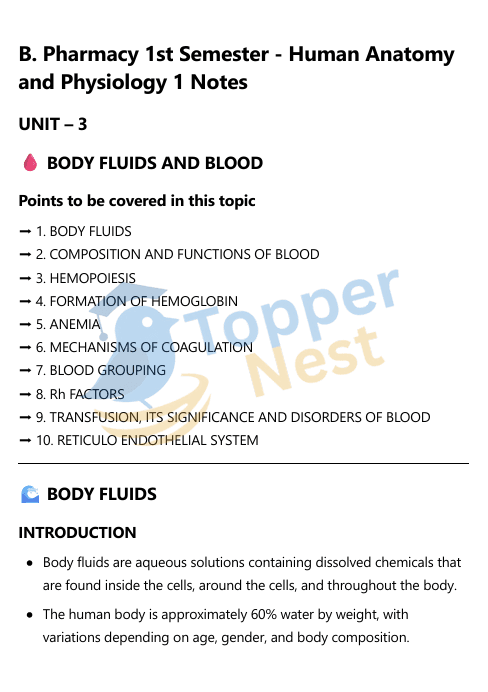Understanding the composition and function of body fluids and the circulatory systems is essential for pharmacy students. This unit explores the two major internal transport systems—blood and lymph. These fluids play critical roles in nutrient transport, immunity, oxygen delivery, waste removal, and drug distribution. Any dysfunction in these systems can lead to severe disorders that pharmacists must be able to understand, monitor and manage.

What is Body Fluids and Blood?
The human body contains essential fluids that help in regulating temperature, transporting nutrients, and removing wastes. One of the most important fluids is blood, a connective tissue that circulates throughout the body. It plays a key role in respiration, nutrition, defense, and homeostasis. For pharmacy students, knowledge of blood helps in understanding disease pathology and pharmacological interventions.
Definition:
Blood is a fluid connective tissue composed of plasma and cellular components (RBCs, WBCs, and platelets). It supports vital functions like oxygen transport, clotting, and immunity.
Key Concepts of Blood and Body Fluids:
- Composition of Blood –
Includes plasma (55%) and formed elements (RBCs, WBCs, platelets). - Hemopoiesis –
The process of formation of blood cells, mainly in red bone marrow. - Formation of Hemoglobin –
Hemoglobin synthesis requires iron and is vital for oxygen transport in red blood cells. - Anemia –
A condition caused by low hemoglobin or RBC count, leading to fatigue and shortness of breath. - Mechanism of Coagulation –
Involves a clotting cascade where platelets and clotting factors stop bleeding by forming fibrin mesh. - Blood Grouping & Rh Factor –
Classification of blood into A, B, AB, O groups and Rh+ or Rh− types, important in transfusion.
What is the Lymphatic System?
The lymphatic system is a part of the circulatory and immune systems. It collects and returns interstitial fluid to the blood, absorbs fats from the digestive tract, and helps defend against infections. It includes lymph, lymph vessels, lymph nodes, and lymphatic organs.
Definition:
The lymphatic system is a network of tissues and organs that help maintain fluid balance and fight infections through immune responses.
Key Concepts of the Lymphatic System:
- Lymphatic Organs and Tissues –
Primary organs: bone marrow and thymus; Secondary organs: lymph nodes, spleen, tonsils. - Lymphatic Vessels –
Thin-walled vessels that carry lymph fluid and connect lymph nodes. - Lymph Circulation –
Lymph flows in one direction—from tissues to blood—filtered by lymph nodes. - Functions of Lymphatic System –
Maintains fluid balance, absorbs fats (via lacteals), and provides immune protection.
Frequently Asked Questions (FAQs)
1. What is the main difference between blood and lymph?
Blood circulates oxygen, nutrients, and hormones; lymph primarily returns tissue fluid to blood and filters it through lymph nodes.
2. Why is hemopoiesis important?
It ensures a continuous supply of blood cells to replace old or damaged ones, crucial for oxygen transport, immunity, and clotting.
3. What causes anemia?
Common causes include iron deficiency, vitamin B12 or folate deficiency, blood loss, or inherited conditions like sickle cell disease.
4. How is the Rh factor relevant in pregnancy?
If an Rh-negative mother carries an Rh-positive baby, it can lead to Rh incompatibility, causing fetal complications in subsequent pregnancies.
5. What are lymph nodes and their function?
Lymph nodes are small, bean-shaped structures that filter harmful substances and house immune cells to fight infections.
